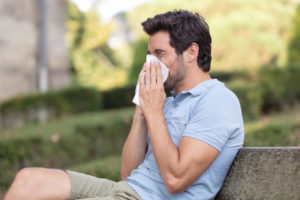Summer Allergies

Allergies are often associated with the spring when plants are blooming and pollen is blowing. However, the dry, hot conditions of summer months in Colorado can also cause allergies to spike, making summer allergies a common problem. Summertime allergies usually begin in June and go through September, with allergy symptoms peaking in June, July, and August. If you’re experiencing allergy symptoms during the summer months, you can learn more about the causes and potential treatments below.
What Causes Allergies in the Summer?

Your individual allergy triggers remain the same throughout the year, but there are several different factors that contribute to the frustrating symptoms of summer allergies:
We’re Outside More
We tend to spend more time outdoors during the warm summer months, which can make it more difficult to avoid common outdoor allergens such as hay, grass, and tree pollen.
Dry Heat Leads to Airborne Allergens
Hot, dry conditions cause grasses and plants with pollen to dry out and break down, meaning they can more easily be blown in by a breeze, carried indoors by a pet, or breathed/touched while outside.
Moist Heat Spreads Mold
Mold is another common summer allergy, and while certain mold spores spread more easily in dry, windy weather, many types of mold thrive in hot, humid environments that can easily develop indoors and outdoors during the summer.
Insects are Thriving
Insect stings are a common allergy, and can be one of the more common causes of a serious allergic reaction called anaphylaxis. Bug bites and stings are more frequent in the summer, which means taking extra caution is necessary.
Types of Allergies in the Summer
The following triggers are the most common causes of summer allergies:
Grass Pollen
Grasses are the commonly reported summer allergy, in part because they grow in almost every region of the U.S. Grass pollen tends to dry out and become airborne in the summer months, leading to intense allergy symptoms for those with grass sensitivities. The most common grasses that cause allergies are Timothy, Kentucky Blue, Johnson, Rye, Fescue, Bermuda, and Bahia grasses.
Tree Pollen
Tree pollens often thrive during the summer months between June and August when the nights are cool and the days are warm. The type and quantity of trees nearby may influence the severity of your symptoms, depending on your specific tree allergies.
Mold
Outdoor molds can worsen summer allergies. Mold spores are sensitive to weather conditions and can increase in concentration during warmer months, through the summer and into early fall. The American College of Allergy, Asthma and Immunology (ACAAI) acknowledges that mold spores can outnumber pollen grains in the air, even during peak pollen count seasons.
Ragweed
Ragweed is an incredibly common plant allergy, and it grows in most areas of the US. This allergen is most active from late summer in August into the fall of November, during which the plant blooms and produces around 1 billion pollen grains. These minuscule, lightweight grains spread easily and cause symptoms similar to pollen allergies.
Mugwort and Nettle
These perennial plants are also common summer allergy triggers and can cause symptoms such as itching, sneezing and hives. Mugwort contains certain proteins that can cause allergies for people who are sensitive to pollen, while nettle can cause allergic reactions through contact with the thin stinging hairs on its flowers, leaves and stems.
Other weeds that commonly cause summer allergies include sagebrush, lamb quarter, tumbleweed, and pigweed.
Summer Allergy Symptoms
Symptoms caused by summer allergy triggers often include:
Several factors determine the severity of allergic reaction from a trigger like summer pollen or mold, including how much is in the air, how long your exposure is, and how sensitive you are to that plant’s pollen or mold’s spores. If you are allergic to multiple pollens or allergens, you may experience more severe or more consistent allergy symptoms. Although allergy seasons are fairly predictable, unexpected weather changes can increase or decrease the usual pollen or mold count, and this can significantly affect symptoms.
Summer allergy symptoms can often be confused with a cold or with COVID-19. Learn how to tell the difference between these symptoms and conditions so you can find the best treatment option.
How to Prevent Allergies in the Summer
Being outside in summer naturally increases your likelihood of exposure to outdoor allergens that cause allergy symptoms. However, there are still several ways you can protect yourself and limit your contact with the triggers that affect you most during the summer months.
Watch the allergy forecast to track pollen counts
Get to know the common pollens in your geographic region, as well as the weather conditions like rainfall or wind that encourage pollens to thrive. Staying aware of the current pollen count in your area can help you decide whether or not spending time outdoors may affect your allergy symptoms. It may be best to stay inside and keep windows closed when pollen counts are highest.
Cover up when outdoors to protect against pollen
Wearing a face covering such as a mask can help prevent pollen from getting into your mouth, nose and eyes. This can be especially helpful when mowing, gardening, or hiking. It’s also a good idea to wear long sleeves or pants to avoid physical contact with allergens such as grass, ragweed and nettle, especially if you will be in an area with lots of vegetation.
Keep indoor air clean
Using air conditioning instead of open windows to keep cool during the summer will help prevent allergens from getting inside. A HEPA air filter can also help catch any allergens indoors. It’s extremely important to change all air filters frequently, at least once every season, to keep them working as well as possible. Showering after going outdoors, limiting pets on furniture, and vacuuming frequently are also great ways to keep your home free of allergy triggers.
Watch home humidity levels
Make sure your home isn’t too humid or dry during the summer months. Too much humidity can cause mold, one of the most common summer allergens, while dryer air can cause dry sinuses and worsen allergy symptoms. Ideal humidity in the home is between 30 – 50%.
How to Treat Summer Allergies
The best treatment for your summer allergies may depend on the type of allergy trigger and severity of your symptoms. Below are some potential treatment options to help you get relief from allergy symptoms.
Over-the-Counter Antihistamines
Available in both pill and liquid form, antihistamines stop the body from producing the histamine compound which causes frustrating allergy symptoms. Antihistamines work best for those who only experience allergies during certain times of year, since they are a short term treatment option and usually need to be taken each day to be effective. Certain over-the-counter allergy medications can cause drowsiness, so be cautious when purchasing and taking antihistamines.
Immunotherapy Allergy Drops
Immunotherapy has long been recognized as the best form of long-term allergy treatment for those who suffer from severe or continuous allergy issues. Allergy drops are a modern form of immunotherapy that eliminates the need for frequent office visits and painful allergy shots. Instead, allergy drops can easily be taken at home each day with a few drops under the tongue, with the same long-lasting effectiveness as allergy shots.
Get Help with Summer Allergies
Don’t suffer through another summer of annoying allergy symptoms. Find out what you are allergic to with an easy allergy test so you can take control of your allergies and find the best treatment. The allergy specialists at AENT can help you determine your exact allergy triggers and explain your options for summer allergy relief. Contact the allergy experts today for an initial consultation.

